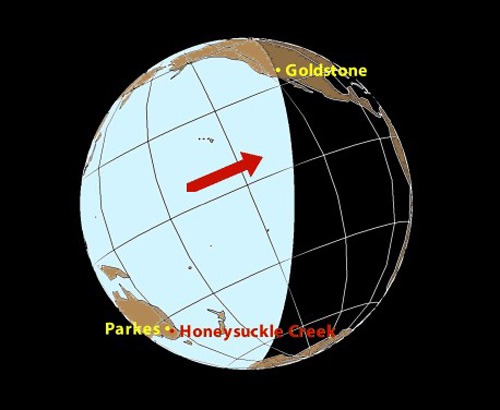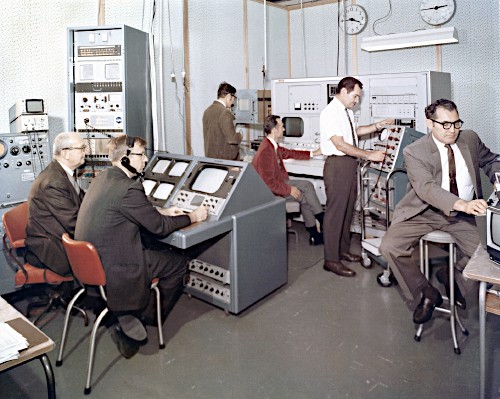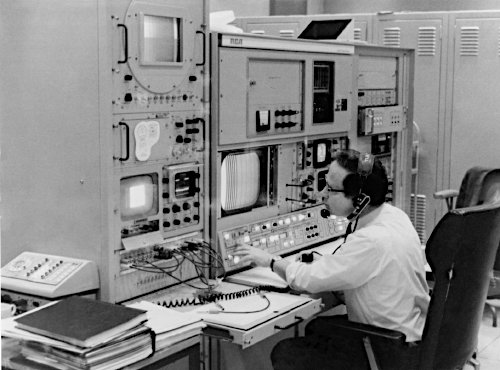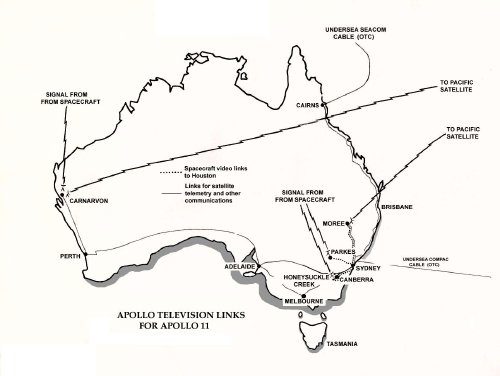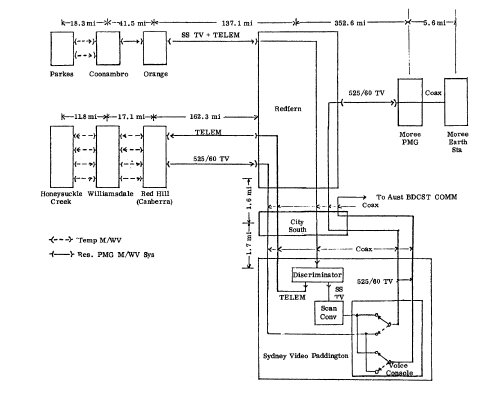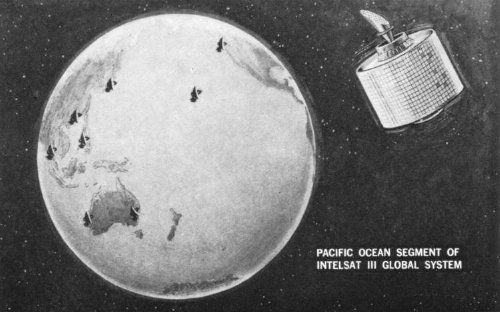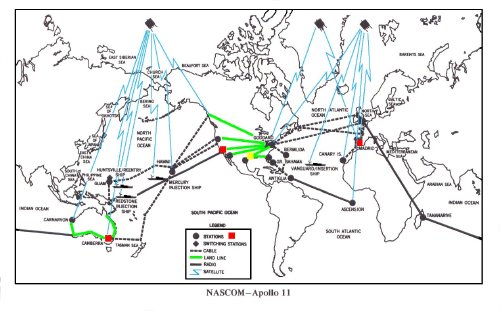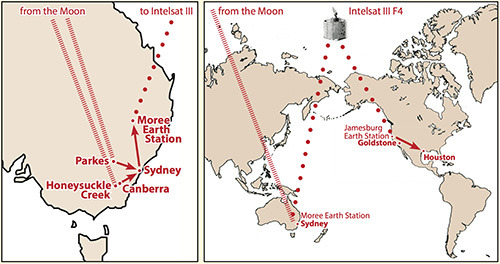The Apollo 11 Lunar Module, “Eagle”,
touched down on the Sea of Tranquility on the morning of Monday 21st July 1969,
Australian time.
Madrid
and Goldstone were
tracking during the Powered Descent and landing – which took place at 6:18am
Eastern Australian time.
The EVA (Extra-Vehicular
Activity) had been scheduled for after an astronaut sleep period. The Moon would
have been high in the sky for Honeysuckle Creek and Parkes, but below the horizon
for Goldstone. Armstrong and Aldrin’s
understandable decision to walk early changed that. It meant that Goldstone
could still see the Moon and would be able to receive the TV.
At Honeysuckle Creek, the
Moon had risen next to Dead Man’s Hill, the high hill due east of the station
at 11:12am.
Both Goldstone and Honeysuckle
relayed voice and telemetry from Tranquility Base as the astronauts prepared
for their EVA.
The larger Parkes Radio Telescope
– not designed for spacecraft tracking – could not tilt as low to
the horizon as Honeysuckle’s dish. Parkes could not see anything lower
than 29°38' above the true horizon. Therefore the Moon did not rise into
its main beam until 1:02pm Eastern Australian time – almost two hours after
it rose for Honeysuckle. However, by using another receiver in a less sensitive
off-axis position, the Parkes dish was able to receive data and television several
minutes before that time.
(See “Parkes
and Honeysuckle” for a discussion on the sequence of events.)
|
|
|
This shows
the side of the Earth facing the Moon as Neil Armstrong stepped onto the
lunar surface at 0256UTC (12:56pm Monday 21 July in Eastern Australia).
The arrow shows the direction
of the Earth’s rotation.
Goldstone and Honeysuckle were
in mutual view.
At Goldstone, the Sun was setting, but the Moon
was still high in the sky. Goldstone handled voice uplink to the Lunar
Module throughout the EVA.
Honeysuckle Creek was also receiving downlinked
telemetry from the Lunar Module. (Loss of Signal with the Command/Service Module
as it moved behind the Moon had happened several minutes earlier.)
Due to mechanical constraints, the Moon was still just
a little too low for the Parkes Radio Telescope to see the spacecraft
using the receiver on its main axis. |
TV
from the Moon
The television camera taken
to the lunar surface was a Westinghouse designed and built slow-scan black and white camera with a vertical
resolution of 320 lines scanned at 10 frames per second. This camera was chosen
because the available bandwidth from the Moon (500kHz) was not sufficient for
a standard TV signal.
On Earth, the received slow
scan signal was converted to a standard TV picture (in this case, the American
standard of 525 lines and 30 frames per second) using specially built scan converters.
At Goldstone and Honeysuckle, the conversion was done on site. The Parkes slow
scan TV signal was sent to the OTC (Overseas Telecommunications Commission)
Paddington gateway exchange in Oxford Street, Paddington, in Sydney and converted
there.
|
|
|
The OTC’s international gateway exchange in the inner Sydney suburb
of Paddington. Photo: John Berry. Click for a larger version. Click here
for another picture. |
At Paddington (‘Sydney
Video’) the best of the two signals from Honeysuckle or Parkes was chosen
and sent to Houston via Intelsat through the OTC Moree ground station. Charlie
Goodman, seasoned communications expert from NASA was responsible for selecting
which signal was sent.
|
|
|
At the Overseas Telecommunications Commissions’s International
Exchange in Paddington, Sydney, a special room was equipped to handle
the Apollo 11 TV – dubbed “Sydney Video” (more officially, the NASCOM TV Operations Center).
NASA’s Charlie Goodman (far left) was responsible for selecting
the better video (out of Honeysuckle or Parkes) for sending to Houston
via the OTC’s earth station at Moree in northern NSW.
From left: Charlie Goodman, Vern McGlynn, Richard Holl, Elmer Fredd
(seated at the scan-converter), Ted Knotts, and Ray Lauver.
Photo: With thanks to Dick Holl for
the photo. Image restoration Colin Mackellar.
Large, Larger (1.8MB). |
|
|
|
A close up view of the console at Sydney Video used to select the
best picture – from Honeysuckle Creek or Parkes.
Foreground: Vern McGlynn is seated at the video program selector, while Ray Lauver is standing behind.
Background:OTC technician Wayne Ozarko is standing at left while NASA’s Dick Holl is standing at the scan
converter.
(With thanks to Wayne Ozarko and Robert Brand.) |
While the TV from Parkes
went direct to Sydney, all the rest of Parkes data was sent (via Sydney) to Honeysuckle Creek, which demodulated Parkes data and combined it with its
own for transmission to Houston.
The Television pictures
As Neil Armstrong made his
way down the ladder of the Lunar Module, he deployed the TV camera, which swung
out from the MESA on the side of the descent stage. Goldstone and Honeysuckle
were monitoring the FM portion of the signal from the Lunar Module, waiting
for a TV signal.
Buzz Aldrin put the TV circuit-breaker
in, and both Goldstone and Honeysuckle simultaneously reported they were receiving
video.
Viewers around the world saw
fuzzy images – upside-down for a few seconds – coming from Goldstone.
The image was high contrast because the scan converter at Goldstone had apparently
been set incorrectly. This compressed most of the video information into the
black, making it almost impossible to discern what was happening.
Just before Neil Armstrong set
foot on the moon, Houston selected the clearer video coming from Honeysuckle
Creek.
|
Download this 4.2MB
PDF file comparing still photos of the pictures on the TV monitors
at Goldstone, Honeysuckle Creek, and Parkes.
(This was put together as a presentation –
hence the format – to demonstrate the differences in quality between
what was seen at the tracking stations and what was recorded at Houston.) |
Photographs
of the TV monitors at Honeysuckle Creek
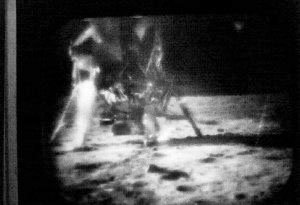 |
In 2003, John
Saxon scanned a set of photographs taken by Ed von Renouard of the
TV monitors on the video console at Honeysuckle Creek as the pictures
came in from the Moon.
See
them here.
See
also a scan
of a Polaroid taken at Goldstone – provided by Bill Wood. |
|
|
|
The
high resolution slow-scan TV monitor is this one at the top of the slow-scan
TV processing rack to the left of Ed von Renouard at the TV operational
console at Honeysuckle.
This
monitor could display the ‘standard’ slow scan picture of 10 frames per second at 320 lines
per frame or a high resolution mode of 0.625 frames per second
at 1280 lines per frame.
In
practice, only the lower resolution video of 320 lines was a part of mission plans and was transmitted
back to Earth.
Directly
above Ed’s head (and clearly visible in the large
version of the photo) is the toggle switch to invert to television
for the beginning of the broadcast when the camera was mounted upside-down
in the MESA on the side of the descent stage of the Lunar Module.
This
photo was taken during the Apollo 12 mission. Scan by Hamish
Lindsay. Large, Larger. |
|
|
|
This diagram by Hamish Lindsay, after a 1969 PMG sketch, gives an
idea of the communications links within Australia used to support Apollo
11.
Note while that Carnarvon tracking station did not have scan-conversion
capabilities – nevertheless, after the Moon rose, staff at the
station were able to extract the slow scan TV and view it within the station (details coming soon).
The nearby OTC Carnarvon earth station nearby received the
television from the Intelsat III Pacific telecommunications satellite. It was this
which was relayed to Perth via coaxial cable. |
|
|
|
The Parkes supplement to the (Goddard) NOD (Network
Operations Directive) Section 36 – dated June 1969.
This document details the timeline for the equipment
setup at Parkes, its integration with Honeysuckle, and the paths for
the various signals from Parkes and Honeysuckle.
Click for the 1.3MB PDF. With thanks to the Apollo 11
Tape Search Team, Sept 2006. |
|
|
|
This diagram – from the Parkes supplement to the (Goddard) NOD
(see above) summarises the links between Honeysuckle and Parkes and
Sydney. |
From Parkes:
The received telemetry (including the Slow Scan
TV) was sent via the temporary microwave link to the Mt. Coonambro repeater,
and then to Orange, and the rest of the way to Sydney via the PMG broadband
microwave link.
The signals then travelled via the Redfern and City
South telephone exchanges, and then into the Overseas Telecommunication
Commission’s gateway exchange in Oxford Street, Paddington.
At Sydney, the Parkes Slow Scan TV was scan converted to 525 lines
/ 60 fields.
From Honeysuckle Creek:
Since Honeysuckle had a scan converter
on site, what was sent to Sydney was telemetry and 525 line / 60 fields
TV.
The TV signal left the microwave tower at Honeysuckle, through a specially
installed microwave dish, to an AWA outside broadcast van parked next to the Cooma – Canberra microwave tower on a hill east of the locality of Williamsdale. Because the Honeysuckle tower did not have
line-of-sight to Williamsdale, a temporary relay tower was built about
a kilometre down the road from Honeysuckle.
From Williamsdale, the link went to Red Hill in Canberra, and then
into the broadband network to Sydney. At Red Hill, the signal was split – so the TV went to Sydney via both the microwave broadband network and also via the coaxial cable.
From Paddington in Sydney there were three feeds going out:
a.) The telemetry and voice from Parkes (including critical information
on LM and PLSS systems) was sent down the link to Honeysuckle, where
it was demodulated and the best data (from Honeysuckle, from its wing at Tidbinbilla or from Parkes)
was used.
b.) The scan-converted TV (selected from either Honeysuckle or Parkes)
was sent back through City South and Redfern exchanges and via microwave
bearers, up to Moree in northern New South Wales.
From the Moree telephone
exchange, the TV went to the nearby OTC Satellite Earth Station, and
then by the Pacific Intelsat III F4 satellite to the US west coast Earth
Station at Jamesburg in California – and then via AT&T links
to Houston. From Houston, the TV was released to the world in real time.
(Contrary to some common misunderstandings, there was no added delay in either
the video or audio – everything was live.)
c.) The only place in the world where the public saw the lunar TV direct,
and not via Houston, was in Australia. This was because, some months earlier,
GSFN engineers sought approval to release a live feed of the TV from
Sydney Video, to the Australian television networks.*
Thus, as the TV was sent from Sydney Video to the Moree Earth Station,
a spilt was sent, via the Post Master General’s Television Operations Centre in Castlereagh Street, Sydney, to the Australian Broadcasting Commission’s studios
at Gore Hill in Sydney’s northern suburbs.
At Gore Hill, engineers used a locally-built optical scan
converter (reportedly mounted on a wooden packing case) to produce a
625 line / 50 fields per second version of the broadcast. The ABC also provided their
625 line feed to the Australian commercial networks, although the Sydney commercial stations TCN-9 and ATN-7 also used their own scan converters.
It was this “Sydney Video” version of the broadcast which was seen by viewers across
Australia (including Perth, who received the signal from Moree via the Carnarvon OTC Earth Station).
* Those stories to come soon.
|
|
|
The Apollo TV was sent from
Sydney Video via PMG lines to the OTC’s satellite earth station
at Moree in northern New South Wales.
From there it was sent to
the Intelsat III F4 geosynchronous telecommunications satellite
above the Pacific Ocean.
This photo of the OTC’s 90 foot Moree dish was taken
from the cover of a 1969 OTC publication. Scan: Colin Mackellar.
Large, Larger. |
|
|
|
Artist’s impression of the Intelsat III Pacific Ocean satellite.
In 1969, NASA was the prime user of the satellite.
From a 1969 OTC publication. Scan: Colin Mackellar. |
|
|
|
NASCOM – The NASA Communications network for
Apollo 11. From a Goddard diagram, with colour added by Hamish Lindsay.
Note: This diagram applies to voice / data. Apollo
11 EVA television from Sydney Video went to the OTC Moree Earth Station,
via Intelsat III to an Earth Station at Jamesburg in California, and
then via landline direct to Houston (while the voice and data went to
Houston via Goddard).
More on NASCOM here. |
|
|
|
The path the TV took from the Australian tracking
stations.
Click for a larger version with notes (350kb PDF). |
Apollo
11 TV index page.
Honeysuckle Creek
home page.
